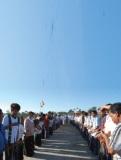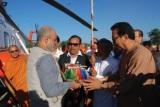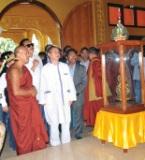Archives
God amidst us 2568 years old relics visit Arunachal
Whatever the practical and theoretical reasons be, the celebration, festivity and the spirit of the people of Tawang, West Kameng and Lohit districts could not be dampened as their deity the Lord Buddha himself, who in the form of Sacred Holy Relics was on a visit to these three respective places from November 16th to December 12th, to serve the interest of the large Buddhist community of Arunachal Pradesh. The main objective behind bringing the 2,568 year old sacred relics to Buddhist inhabited districts of Arunachal Pradesh was to spread peace, harmony and tranquility and to inculcate Buddha’s teaching among the people.
The relics of Lord Buddha were excavated enclosed in a casket at a hillock at Piprahwa in the district of Basti in Uttar Pradesh in 1898 by an Archaeologist named W C Peppe. The excavations conducted by the Archaeological Survey of India between 1971 and 1977 resulted in the discovery of two more un-inscribed steatite caskets with 22 sacred bone relics in it. The sacred relics are in layman’s term the mortal remains of Buddha.
On hearing on the news of the visit of the sacred holy relics to their places, the joy of people knew no bounds as they flooded their districts with prayer, amidst the chanting of hymns and traditional sacred music and a mood of festivity. To welcome and pay their homage to the sacred holy relics, people of all ages wore their best traditional attire. The sacred holy relics which were flown in from the National Museum in New Delhi, and which arrived via Guwahati by air on the first and second leg of the visit, were kept for viewing for the people of Tawang and West Kameng district respectively. People from all places of the two districts and far flung areas besides from neighboring districts and States and also from other countries paid a visit to witness and to pay obeisance to the deity among them. This thus make Tawang the first ever district in the entire Northeastern region to have the privilege to showcase and receive the holy relics.
 These Kapilavastu relics (four out of 22 pieces of the relics), considered to be the most genuine relics of Lord Buddha, were brought to the State for the first time at the initiative of Rev. Rinpoche with the patronage of Chief Minister Nabam Tuki. Besides making history, the relics were provided with Z plus security arrangement where the installation of the relics was done inside a well-protected glass chamber under CCTV and round-the-clock security surveillance.
These Kapilavastu relics (four out of 22 pieces of the relics), considered to be the most genuine relics of Lord Buddha, were brought to the State for the first time at the initiative of Rev. Rinpoche with the patronage of Chief Minister Nabam Tuki. Besides making history, the relics were provided with Z plus security arrangement where the installation of the relics was done inside a well-protected glass chamber under CCTV and round-the-clock security surveillance.
The expo in the district of Tawang and West Kameng was organised by Department of Karmik and Adhyatmik (Chos-Rig) Affairs, of the State Government and in Lohit district the exposition was organized by the district administration in collaboration with the National Museum under the Union Ministry of Culture, New Delhi.
The final leg of the expo of the sacred holy relics was organized at Lohit district. For this, the relics were flown from West Kameng district in a Pawan Hans Chopper escorted by State Tourism Minister Pema Khandu, curator KKS Deori, assistant chemist Satish Kumar Jaiswal and head modeller R K Rai of the National Museum Delhi and a group of monks on December 4. The relics were received by thousands of devotees, including monks led by Union Minister of State for Minority Affairs Ninong Ering, Rajya Sabha member Mukut Mithhi and a host of ministers, including Finance Minister Chowna Mein.
| The relics of Lord Buddha were excavated enclosed in a casket at a hillock at Piprahwa in the district of Basti in Uttar Pradesh in 1898 by an Archaeologist named W C Peppe. |
A traditional welcome was accorded at the entrance of the Golden Pagoda where the relics were installed in a bullet-proof glass box. A massive security blanket was spread around and within the venue for the safety of the national treasure, taken out in India for the second time after Ladakh. Once it was taken to Sri Lanka for exposition too.
Before the rituals by the monks, Mein, who founded the Pagoda in February 2010, told the gathering that the people of Arunachal Pradesh have been blessed as the relics would bring greater welfare, peace and prosperity for all living beings on the earth. He lauded Union Cultural Affairs Minister Chandresh Kumari Katoch, National Museum Director General Venu V, Rev T G Rinpoche, Pema and Sonam for their initiative to bring the relics to the State. “This is an opportunity which may not come in 100 or 200 years,” he said.
 Arunachal Pradesh Chief Minister Nabam Tuki who also arrived in Lohit Disitrict on December 6th to pay homage to the holy relics said that the State is poised to be a major religious tourism destination of the country. “While the world famous Tawang Monastery attracts tourists in the State’s western part, Buddhist town Mechuka in the north and the Golden Pagoda including the famous pilgrimage Parsuram Kund in the east have been the cynosure of all eyes,” Tuki said before paying his obeisance to the 2,568 year-old relics of Buddha which arrived at the Pagoda on December 4th. The Chief Minister said that with several infrastructure projects in this part of the State coming up including the Trans - Arunachal Highway and railway - Arunachal Highway and railway connectivity to Tezu, the headquarters of Lohit district, besides the close proximity to the airport in Assam’s Dibrugarh district, religious tourism would thrive.
Arunachal Pradesh Chief Minister Nabam Tuki who also arrived in Lohit Disitrict on December 6th to pay homage to the holy relics said that the State is poised to be a major religious tourism destination of the country. “While the world famous Tawang Monastery attracts tourists in the State’s western part, Buddhist town Mechuka in the north and the Golden Pagoda including the famous pilgrimage Parsuram Kund in the east have been the cynosure of all eyes,” Tuki said before paying his obeisance to the 2,568 year-old relics of Buddha which arrived at the Pagoda on December 4th. The Chief Minister said that with several infrastructure projects in this part of the State coming up including the Trans - Arunachal Highway and railway - Arunachal Highway and railway connectivity to Tezu, the headquarters of Lohit district, besides the close proximity to the airport in Assam’s Dibrugarh district, religious tourism would thrive.
While appealing to the people not to leave any stone unturned in preserving the uniqueness of the Golden Pagoda, Tuki said that with the arrival of the relics, the place had turned into a holy land of Lord Buddha. The expo of the relics for the public began on December 6th with the Chief Minister paying his obeisance after being administered Panch Sheel (five golden principles of Buddha) by the monks of the Hinayana sect of Buddhism.
Through information received from the three districts, lakhs of devotees from within and outside the State had witnesses this momentous occasion during the days of the expo of the sacred holy relics at the three Buddhist places of Arunachal Pradesh.
In a telephonic conversation regarding the exposition of the sacred holy relics, a friend from Tawang said that this was a lifetime opportunity and the participants are witnessing history. With the arrival of Lord Buddha, the land and the people have been blessed. Another friend from Lohit district, Chow Moungseng Mounglang believes that the expo of the relics has benefited the lay Buddhist to live a life of devotion to the ideas and the teaching of Lord Buddha which have guided and influenced the lives and thoughts of countless human beings in many parts of the world.
The devotees with thousand years’ old Buddhist tradition have conveyed their gratefulness to the Centre and the Arunachal Pradesh Government for the lifetime opportunity, which was availed by devotees from various parts of the world and neighboring States to pay respect to Lord Buddha. The arrival of the relics has definitely brought religious tourism of the Arunachal Pradesh to the forefront. It can be said that the religious tourism has been redefined by this unique event.

